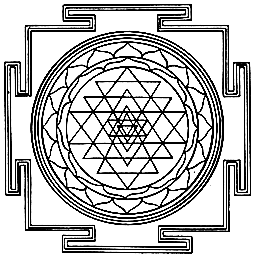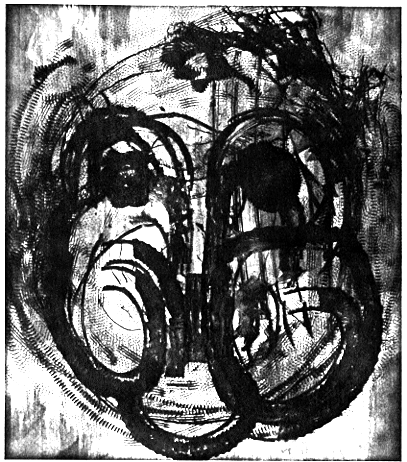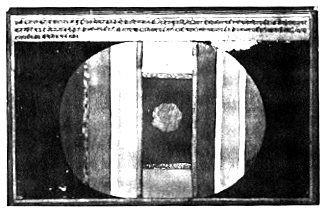
The Symbol of Beauty
Symmetry in Nature
Deconstructing Beauty
Symmetry in Art History
Asymmetry
Conclusion
References
Figures
"Beauty is an ecstasy; it is as simple as hunger.
There is really nothing to be said about it."
----W. Somerset Maughan 1.
One of the more striking observations to be made about nature is the
strong propensity towards symmetry and repetitive patterning.
Symmetry is evident in living and non-living structures. Throughout
the ages, from primitive tribal communities to modern electronic
civilizations, symbols have been used to describe the simple,
complex, tangible and intangible. These symbols display a wide
range of materials and techniques, yet they also carry a common
denominator. This common thread is the composition of symmetry which
is influenced by nature and the environment. It is a recurring visual
composition which has evoked passion in all human beings. But what
exactly is this passion and from where does this passion come? In
comparing and contrasting art objects throughout history it becomes
clear that symmetry is a basic concept for creating images and that
there are a wide range of objectives associated with these images.
Is their an innate link between symmetry and the end goals of these
art objects? Could symmetrical composition be an intricate part of
defining beauty?
Sandollars, sea shells, flowers, faces, fish (even flounders)... the
list goes on and on. Each item offering a unique form immersed in
symmetry. In detail, there are always imperfections rendering an
object not perfectly in equilibrium but the overall form is
symmetrical. Symmetrical patterns in nature have influenced artists
and architects throughout history and have played an important role
in the shaping of our environment as well as the creation of our
culture and society. The use of symmetry in nature is so strong that
it is being used in physics to develop a unified field theory.
"Unified field theory, in physics, is a theory that proposes to
unify the four known interactions, or forces - the strong
(a short-range force that holds atomic nuclei together),
electromagnetic, weak (the force responsible for slow nuclear
processes, such as beta decay), and gravitational forces - by a
simple set of general laws....An important advance in this quest
was made in 1967-68 by the American physicist Steven Weinberg and the
Pakistani physicist Abdus Salam. They succeeded in unifying the weak
interaction and the electromagnetic interaction by using a
mathematical technique known as gauge symmetry. Theoretical
physicians are currently attempting to combine this so-called
electroweak theory with the strong nuclear force, using symmetry
theories; such attempts are known as grand unification theories.
The effort also continues to combine all four fundamental interactions,
including gravitational, in what are now known as supersymmetrical theories"2.
So strong is symmetry in nature that it is obvious through topical observation
and is used to develop new theorems in physics.
Symmetry is also an innate characteristic of human psychology. "As
infants, humans have a preference for looking at faces. Young infants
also prefer looking at complex patterns such as a bull's eye or a
checkerboard rather than simple ones"3. It is truly fascinating when
infants are learning to focus. Their pupils dilate and narrow as they
begin the process of vision. First in black and white and later in
color the visual world is a new experience and being able to
recognize providers and threats is a challenge. The first images
infants focus on are faces. These faces provide the infant with a
reference of survival. It is in these symmetrical images that the
newborn infant realizes a new security. The infant can find peace
and reassurance in recognizing a parent. The human being is a complex
organism which itself is symmetrical. When we first encounter a
newborn our fears are centered around health. Is the baby OK? Does
the baby have two hands, two feet, five fingers on each hand and
foot? Health is immediately perceived through visual symmetry. Once
the newborn has passed this visual exam, it is beautiful, it is
perfect, and with this notion comes a complete feeling of happiness.
A joy that dispels all the fears of deformation and proves them to be
false. Is there a link between symmetry and beauty? Is symmetry the
symbol of beauty?
What is beauty?
The idea or negative conjecture of deconstructing beauty is a lofty
task worthy only of hundreds of pages of text or none at all. Yet the
aim of this section is to link ideas of the symmetrical composition
in the visual art object and aesthetics of beauty. So...
What is beauty?
"With a friend, I went out on a flat headland that is almost a tiny
island, being all but surrounded by the waters of the bay. There the
horizons are remote and distant rims on the edge of space. We lay
and looked up at the sky and the millions of stars that blazed in
the darkness. The night was so still that we could hear the buoy on
the ledges out beyond the mouth of the bay. Once or twice a word
spoken by someone on the far shore was carried across on the clean
air. A few lights burned in cottages. Otherwise there was no reminder
of other human life; my companion and I were alone with the stars.
I have never seen them more beautiful: the misty river of the Milky
Way flowing across the sky, the patterns of the constellations
standing out bright and clear, a blazing planet low on the horizon.
Once or twice a meteor burned its way into earth's atmosphere."
----Rachel Carson 4.
"Aristotle held that happiness is the aim of life, he believed that
the major function of art is to provide human satisfaction. In the
Poetics, his great works on the principles of drama, Aristotle argued
that tragedy so stimulates the emotions of pity and fear, which he
considered morbid and unhealthful, that by the end of the play the
spectator is purged of them. This catharsis makes the audience
psychologically healthier and thus more capable of happiness"5.
Could it be that the current anti-aesthetic is a modern manifestation
of the catharsis Aristotle described in the Poetics? Take for
example, the case of Serras' Tilted Arc, an aesthetically beautiful
form. The public art controversy surrounding Serra's work revealed a
dynamic tragedy, of which Serra himself could not recognize. In
encountering the Tilted Arc, people were denied easy access to their
place of "work", this expanded their love of freedom and mobility.
In coming face to face with the fear of restricted movement, the
people fought vehemently for their freedom. Though the purpose of the
artist may have been to expand the peoples notion that going to work
was not a freedom it exposed other fears of confinement which
citizens of a densely populated area such as New York City have
repressed. In hindsight, the true art created, was much larger in
scope than Serra could ever have imagined. But what about beauty?
"The German philosopher Arthur Schopenhauer believed that the forms
of the universe, like the eternal Platonic forms, exist beyond the
worlds experience, and that aesthetic satisfaction is achieved by
contemplating them for their own sakes, as a means of escaping the
painful world of daily experience".6 These forms regularly take on
the natural designs of symmetry. "George Groddeck advocated a
philosophy which allowed ample space for quiet contemplation rather
than eternal search. True happiness is given to the children of God
in their sleep - not in any frantic striving. For the experience of
happiness we need mastery of outer reality, which is symbolized in
the search and mastery of the inner reality, which is symbolized in
contemplation"7.
Following this trail of quotes one comes to the natural conclusion
of examining the symbols of the Tantra associated with meditation.
"Yantras are the most visual means used in the Tantrik cult. Among
them are the diagrams in which energies are concentrated - visual
parallels to the verbal mantras. They focus the energies of the
meditator, and correlate all his previous efforts and knowledge into
single divine images, which are often used in cumulative series. The
most important part is the Shri yantra, composed of nine
interpenetrating triangles, symbolic of male and female, which give
rise to the circuits of other triangles. It presents a condensed
image of the whole of creation"8. These Yantras (visual mantras)
are symmetrical in character and are meant to be focused upon in
deep contemplation to achieve nirvana, "a transcendent state free
from suffering and individual phenomenal existence"9. Through
analysis of these selected interpretations, beauty can be understood
as that which creates happiness or satisfaction in the beholder.
Without the slightest doubt beauty is in the eye of the beholder yet
it consistently appears that beauty generally is observed in nature
or in an image which symbolizes nature such as a Yantra. Symmetrical
objects create an image from which only one type of focus is
permitted, into the image. Duchamp remarks of his Bicycle Wheel: "To
see that wheel turning was very soothing, very comforting, a sort of
opening of the avenues onto other things than the material life of
everyday"10. For Duchamp, concentrating on the spinning tire was akin
to watching a fire, it enthralled him and took his mind away from the
grueling concepts and decisions which he was encountering in his
everyday life. It is through Duchamp's happiness in which the beauty
of the Bicycle Wheel can be defined.
From the ancient representations of rulers or
gods in the form of masks and idols to current images such as the whimsical
painting The Midnight Ride of Paul Revere (fig.1) by
Beattie & Davidson, which
appeared in the 43rd Biennial Exhibition of Contemporary Painters at
the Corcoran Art Museum, the symmetrical representation of faces has
been evident in art objects throughout history. The human figure has
also been represented in a multitude of ways through strong
symmetrical compositioning. The classic example is Leonardo DaVinci's
drawing using geometric symmetries of the square and circle to define
human proportions. The use of symmetry can achieve several goals for
an artist or architect. Le Corbusier's Phillips Pavilion in Brussels
invigorates and excites as one approaches creating an uplifting
feeling created by upwardly sweeping lines. On the other hand, the
Parthenon at the Acropolis reinforces a notion of power through a
balanced design. Some images serve to symbolize abstract concepts of
reality, the Fertilized World Egg (fig.2) from the Rajasthan 18th
century, directly represents reproduction. This concept is reflected
and supported by a contemporary ceramic sculpture entitled Dango
(fig.3) by Jun Kaneko. Past and present merge together when viewing
composition and symbolism. Allen Jones' Hatstand (fig.4) from 1969 is
a boisterous symbol of modern erotic fantasies. Analogous is the
Apollo of Tenea (fig.5) from Corinth 550 B.C. one of the many
"Kouroi" figures meant to represent not gods but young men. One can
only speculate whether these statues are sexual symbols yet they can
readily achieve those ends when analyzed in terms of human social
behavior. These examples are symmetrical in design and achieve
similar objectives however each piece is created in a distinctivly
different era from its partner. Artworks throughout the ages can be
compared quite easily using symmetry as a principle.
For Barnett Newman, his paintings were complex symbols of genesis.
Though he publicly rejected "mysticism", Newman pointed out "'the
artist must start, like God, with chaos, the void: with blank color,
no forms, textures or details.' Newman's first move is an act of
division straight down creating an image. The image not only
re-enacts God's primal gesture, it also presents the gesture itself,
the zip, as an independent shape"11. Newman's paintings are
exceptional illustrations of symmetry in action. His "zip" divides
the canvas creating two parts which together create a whole. Newman's
paintings exploit the use of symmetry to achieve a personal symbolic
quality. There are many artists which use symmetry to construct
beauty, in spite of that, there have also been a myriad of artists
which have created beautiful images using "asymmetry". How does
asymmetry fit into this thesis of symmetry being the substance of
beauty?
Symmetry is defined as orderly, mutually corresdonding arrangement of
various parts of a body, producing a proportionate, balanced form12.
The various types of symmetry include radial symmetry, bilateral
symmetry and planar symmetry. Asymmetry is defined as lack of
proportion or ill-proportioned13. When artists work are described as
asymetrical this is a mislabeling in the description of their work.
Even though an artwork does not represent pure reflected geometrical
symmetry it is still operating under a process of proportional
systems and balancing. "Ma Yuan, a Chinese landscape painter of the
12th century, is described as a leader of the imperial painting
academy at Hangzhou (Hangchow). His works represented a new style in
painting - lyrical, evocative, restrained - in contrast to the more
grandiose style of earlier centuries. The most striking
characteristic of Ma's monochromatic ink paintings is their
asymmetrical composition: The principal forms of the picture - trees,
rocks, and human figures - are grouped in a lower corner. He achieved
a balanced asymmetry, in which the blank areas of his paintings focus
attention on the subject and at the same time suggets a limitless
expanse of space..."14. Bare Willows and Distant Mountains (fig.6)
is almost always cited as one of Ma Yuan's masterpieces. Because Ma
Yuan's paintings are not overtly geometrically symmetrical they are
thought of as asymmetrical. But the intricate balancing of space Ma
Yuan achieves in his compositioning is directly related to the
symbology of yin and yang both philosophically and literally. When
thought about in these terms, terms of zen spirituality, it becomes
clear that Ma Yuan's painting is not asymmetrical at all. Yuan's
balancing of forms and spaces unites a seemingly asymmetrical beauty
with the beauty of symmetry and human proportion. In fact it is
somewhat amusing that a western source would site Ma Yuan's painting
as asymmetrical and turn a blind empirical eye to the spiritual
reality of the zen philosophy which deeply lives in Yuan's paintings.
Though art has made many transformations throughout time the
underlying symmetrical composition of the image has remained a
constant. The inborn inclination of humans to be attracted to
symmetry coupled with the natural desire or pursuit of happiness
leads to the premis that symmetry is indeed the symbol of beauty.
Symmetrical properties are significant with respect to how artists
analyze the world around them, how they are influenced by other
cultures or artists and what they gleam from their works. Because we
visualize a symmetrical world and find happiness in the contemplation
of the natural, we create symbols to describe this emotion. These
symbols have been formed in a vast array of materials, techniques
and cultural circumstances however their symmetrical design crosses
over all these variations and bonds these images together.
1.) Saavedra, Beth Wilson; Meditations for new Mothers;
quoting W. Somerset Maughan; p.138; 1992.
2.) Encarta-Mutimedia Encyclopedia; Microsoft(c) 1993
Funk & Wagnall's Corporation
search topic - Unified Field Theory.
3.) Dodson, Ph. D., Fitzhugh and Alexander, M.D., Ann;
Your Child: Birth to Age 6; p.148; 1986.
4.) Carson, Rachel; The Sense of Wonder; p.54; 1956.
5.) Encarta-Mutimedia Encyclopedia; Microsoft(c) 1993
Funk & Wagnall's Corporation
search topic - Aesthetics.
6.) ibid.
7.) Grotjahn, M.D., Martin; The Voice of the Symbol; p.39; 1971.
8.) Rawson, Phillip; Tantra: The Indian Cult of Ecstasy; p.33; 1973.
9.) Encarta-Mutimedia Encyclopedia; Microsoft(c) 1993
Funk & Wagnall's Corporation
search topic - Nirvana.
10.) Duchamp, Marcel; The Creative Process
in Arman, Yves; Marcel Duchamp: Plays ands Wins;
catalog to the exhibition Marcel Duchamp
at Gallery Yves Arman, N.Y., Mar. 13 - Apr. 28, 1984 ; p.49; 1984.
11.) Hess, Thomas; Barnett Newman;
p.56; The Museum of Modern Art New York; 1971.
12.) Encarta-Mutimedia Encyclopedia; Microsoft(c) 1993
Funk & Wagnall's Corporation
search topic - Symmetry.
13.) Websters Seventh New Collegiate Dictionary(c) 1967; p.55.
14.) Encarta-Mutimedia Encyclopedia; Microsoft(c) 1993
Funk & Wagnall's Corporation
search topic - Ma Yuan.
Other Sources
Rushing; Ritual and Myth: Native American Culture and Abstract Expressionism
in The Spiritual in Art: Abstract Painting 1890 - 1985;
Los Angeles County Museum of Art; p.291; 1986.
Collier, Graham; Art and the Creative Consciousness; p.97; 1972.
Burnham, Jack; The Structure of Art; p.28; 1971.
Rubin, William; Frank Stella; p.22; 1970.
David Salle; Museum Boymans-van Beuningen Rotterdam, Feb. 26 - Apr. 17, 1983
p.38; 1983.
Richter, Gottfried; Art and the Human Conciousness; p.70 - 80; 1982.
Gablik, Suzi; Progress in Art; p.82; 1976.

by Beattie & Davidson; 1993.


Rajasthan; 18th century


by Jun Kaneko; 1993


by Allen Jones; 1969


Corinth; 550 B.C.


by Ma Yuan; late 12th century




coffin@evl.eecs.uic.edu
coffin@art.net










